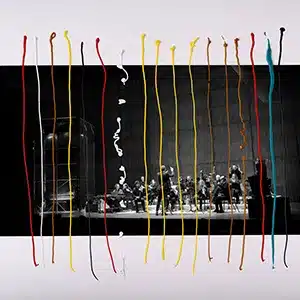
It’s no surprise that Jameszoo’s warm, textured compositions work in a variety of settings. Music for 17 Musicians is brilliant and inspired.
 Music for 17 Musicians Jameszoo / Asko|Schönberg Brainfeeder 30 May 2025
Music for 17 Musicians Jameszoo / Asko|Schönberg Brainfeeder 30 May 2025
In 2019, Dutch composer, producer, and musician Jameszoo (born Mitchel van Dinther) delved deeper into the music of his bright, weird electronic debut album, Fool, by collaborating with Jules Buckley and Metropole Orkest to create an organic and electronic reinvention. That result, Melkweg, was obviously a satisfying project for van Dinther, as the cycle now continues with Music for 17 Musicians, itself inspired by Jameszoo‘s 2022 album Blind.
Collaborating with the Dutch ensemble Asko|Schönberg, percussion group HIIIT, as well as Niels Broos, Petter Eldh, and Richard Spaven from Blind, van Dinther has successfully brought a new perspective to a previous project. The result is Music for 17 Musicians, which essentially explores Blind with the aid of new musicians and, consequently, a different palette. The orchestrations lend the songs a more organic feel, without sacrificing the compositional strength of the previous record. What’s more, the record benefits from van Dinther’s use of a Disklavier, an acoustic piano outfitted with electronic sensors for recording and playback.

The opening track, “(egg modern)”, is a dramatic, often frenzied piece, making use, as do many of the songs here, of a variety of small movements within the song. The same can be said for “(music for bat caves)”, which is introduced with quick, spiky notes but also veers off into warm acoustic guitar picking, followed by post-bop saxophone squalls and a trace of J Dilla beats. The pure, unvarnished instrumentation is always complemented nicely by the electronics.
For all its idiosyncrasies, Music for 17 Musicians is also a record that swings and grooves. The stylish “(Bugatti)” is a perfect example, with bold piano working overtime with fat chords and dazzling solos, and “(lmps”) lays down a sparse funk template with chunky organ and dazzling synths. Still, van Dinther is, above all, an experimentalist, and as much as you’ll find your hips shaking during long stretches on this album, it’s also dense, complex, and weird as hell. The curious “(song)” works through so much shapeshifting that it’s hard to keep track, and “(Big Game)” is a wild hybrid of jazz, furious dance rhythms, and orchestral blasts.
One of the strongest songs is “(Hommage a qui)”, which moves deliberately through melodic woodwinds that blend perfectly with their synth counterparts, with layers of sweeping film score gestures and moody grooves. The seemingly abstract combinations that would ordinarily come off as aimless noodling are perfectly executed.
It’s no surprise that van Dinther’s warm, textured compositions work in a variety of settings. It’s almost as if he seems to know that himself, and is eager to share as many different sides of his music as possible. Far from a retread, Music for 17 Musicians is a brilliant and inspired reimagining.


